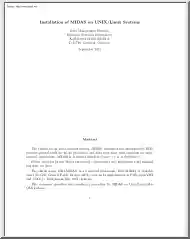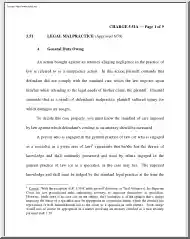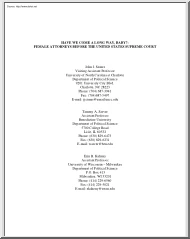Nincs még értékelés. Legyél Te az első!
Mit olvastak a többiek, ha ezzel végeztek?
Tartalmi kivonat
Source: http://www.doksinet Leading Thoughts Mastering the Martial Art of Leadership Harnessing Power & Elevating Effectiveness: Part 3 By Robert Pater P Safety professionals can extend their perceptions by developing leadership antennae to help determine what is happening, inside themselves and within their organizations. rincipled leadership is powerful. It means having a consistent set of practical strategies that guide decisions and actions, which is especially important during pressured or challenging times. The best principles are those that have been tested and proven. Select martial arts are based on a core understanding of human nature: It is easier and more effective to slightly block forces than it is to perpendicularly block them. When you push on someone, that person’s instinctive reaction is to push back. Attention precedes action and much more. Martial arts master Miyamoto Musashi identified nine guidelines to help strategists become effectiveists. In the past
two issues of Professional Safety, I have covered the first six guidelines and shared ideas for applying them to organizational and safety leadership. This month, we’ll review the remaining three principles. I have applied these over more than 3 decades in the field, with an array of companies worldwide. They work, and I encourage you to apply these principles to achieve higher-level leadership. 7) Perceive Those Things That Cannot Be Seen Master martial artists develop fine-tuned sensing mechanisms. As Wing Chun Sifu Chow Hung-Yuen says, “You feel the force, you don’t see it. When you see it, it’s too late.” In real fighting, just as in real life, forces change rapidly and continuously. As a safety professional, you can extend your perceptions by developing leadership antennae. You can assume greater control only after you accurately determine what is happening, both inside of you and within your organization. It helps to look out for the invisible factors that determine
organizational reality: •climate (atmosphere, mood); •hidden agenda (notice which stories and tasks others keep returning to); •intentions; •conflicts; •areas most resistant to change; •what tasks or jobs do not get done; •who gets promoted and who does not; •what the competition is doing; •reactions of those you serve (solicit feedback from those who do not offer it independently); •environmental factors that affect productivity and morale (e.g, color, sound, use of space, lighting, temperature); Robert Pater, M.A, is managing director of Strategic Safety Associates/MoveSMART (www.movesmartcom) Clients include ADT, Airgas, Alaska Tanker Co., Amtrak, BASF, BHP Billiton, BP, Domtar, Dynegy, Halliburton, Hawaiian Airlines, Honda, Marathon Oil, Martin-Brower, Mead Westvaco, Michelin/BF Goodrich, MSC Industrial Supply, Nissan, Textron, Therma-Tru, Tucson Electric, United Airlines, U.S Steel and Vigor Industrial. Pater has presented at numerous ASSE conferences and
delivered 28 ASSE webinars His book, Leading From Within, has been published in five languages. 26 ProfessionalSafety MAY 2016 www.asseorg •proximity of offices; •community perceptions of the organization. These unseen factors form an early warning system that signals organizational success or failure. W. Edwards Deming warned managers to not overly rely on statistics. If you extend your leadership antennae and stay in touch with your organization’s culture, you may be able to sense loss of momentum, identify incipient customer dissatisfaction or recognize when it is the right time to act. Responding early will save valuable time and address problems before they take hold. You will also be able to seize opportunities as they appear. 8) Pay Attention, Even to Trifles Slight changes in hand and foot position can be the difference between effortlessly deflecting force and hopelessly struggling for control. Similarly, black-belt leaders note which small issues indicate an
impending period of low morale, and whether bursts of enthusiasm are real or artificial. In other words, the trifles of today may become the troubles of tomorrow. In most organizations, communication travels in an inverted pyramid. Grassroots rumors start at lower levels of an organization, so pay close attention to the morale and performance of entry-level personnel. Consider going to lunch or having coffee with new staff; they see the organization with fresh eyes. Nurture hourly staff; those in relatively low-paying, low-status positions likely have more contact with customers than any other employees. In addition, pay attention to the effects of small things, such as vacation schedules or when to call staff meetings. Learn to feel and use an organization’s natural forcescompetition, attractions, jealousies, desire for or resistance to changetoward increasing company strength. 9) Do Nothing That Is of No Use Martial artists learn that efficient movements are strong and fast. The
same is true in leadership Looking busy, attending meetings and making calls are not important. Getting the job done is Effective leaders do not squander energy on needless worry or tension. Being relaxed means using only as much energy as needed to accomplish a task. Relaxation is an ally It releases bound energy and generates a feeling of power. Leaders can develop this skill with practice Relaxed leaders who can stay calm are more efficient. During turmoil, such leaders can see opportunities unfolding. They believe in themselves and, consequently, so do their employees. It is also best to make only those business decisions that are necessary. Time is any executive leader’s most precious resource, and must be used wisely, not wasted on meaningless tasks. In Zen iStockphoto.com/g muradin Source: http://www.doksinet in the Martial Arts, Joe Hyams suggests that leaders must “conquer haste.” Leaders must not succumb to pressure to make hasty decisions or become internally
hurried, even while progressing rapidly through tasks. Too many leaders react too soon. Waiting and watching can be the best course of action. Overactivity can harm a project. Being caught up in a frantic need for activity wastes energy and power, and depletes resources that an organization requires when it is time to act decisively. Ultimately, total positive action is the bottom line. A positive attitude is a good start, but it is not enough by itself because it only determines how one initially approaches something. It is more effective to combine this with the mindful perception of what’s happening now. General Norman Schwarzkopf contends, “Leadership is a potent combination of strategy and character.” While charactera leader’s true intent, Relaxed leaders who can stay calm are more efficient. During turmoil, such leaders can see opportunities unfolding. They believe in themselves and, consequently, so do their employees. Connect. Learn Succeed A community is here to
support you. Learning opportunities and certification maintenance resources are waiting for you. Join us in the Bowen EHS® Member Center. ASP CSP CIH C H MM • LIVE Webinars • Quizzes • Forums • Podcasts • LIVE Study Sessions • 1000+ Study Questions trustworthiness, concern for others, self-honesty and moreis essential to highest leadership, so, too, is truly effective strategy. Consider applying one or more of Musashi’s nine principles to strengthen your organization’s safety, leadership and culture. Work need not lead to breakdowns in personal safety or diminish quality of life. In fact, the opposite is true. Individual growth and development can be readily accomplished through dedication, training and mindfulness. By controlling yourself, strategically increasing your organizational power and acting courageously, you can become a black-belt leader. Read parts 1 and 2 of Robert Pater’s “Mastering the Martial Art of Leadership” series on the PS Extra web
page (www.asseorg/psextra) SAFETY CULTURE. IS NOT WHAT YOU HEAR PEOPLE TELL YOU. It’s what they don’t tell you, and what you don’t hear THAT is the real safety culture. Now, with e-Profile, you can measure it. Come and see us at booth 1029 at Safety 2016 Learn More AIHce 2016 - Booth #935 SAFETY 2016 - Booth #2720 Safety is not our business, it is our passion CANADA // USA // AUSTRALIA // SOUTH AFRICA // CHILE // NETHERLANDS // BRAZIL www.safemapcom www.asseorg MAY 2016 ProfessionalSafety 27
two issues of Professional Safety, I have covered the first six guidelines and shared ideas for applying them to organizational and safety leadership. This month, we’ll review the remaining three principles. I have applied these over more than 3 decades in the field, with an array of companies worldwide. They work, and I encourage you to apply these principles to achieve higher-level leadership. 7) Perceive Those Things That Cannot Be Seen Master martial artists develop fine-tuned sensing mechanisms. As Wing Chun Sifu Chow Hung-Yuen says, “You feel the force, you don’t see it. When you see it, it’s too late.” In real fighting, just as in real life, forces change rapidly and continuously. As a safety professional, you can extend your perceptions by developing leadership antennae. You can assume greater control only after you accurately determine what is happening, both inside of you and within your organization. It helps to look out for the invisible factors that determine
organizational reality: •climate (atmosphere, mood); •hidden agenda (notice which stories and tasks others keep returning to); •intentions; •conflicts; •areas most resistant to change; •what tasks or jobs do not get done; •who gets promoted and who does not; •what the competition is doing; •reactions of those you serve (solicit feedback from those who do not offer it independently); •environmental factors that affect productivity and morale (e.g, color, sound, use of space, lighting, temperature); Robert Pater, M.A, is managing director of Strategic Safety Associates/MoveSMART (www.movesmartcom) Clients include ADT, Airgas, Alaska Tanker Co., Amtrak, BASF, BHP Billiton, BP, Domtar, Dynegy, Halliburton, Hawaiian Airlines, Honda, Marathon Oil, Martin-Brower, Mead Westvaco, Michelin/BF Goodrich, MSC Industrial Supply, Nissan, Textron, Therma-Tru, Tucson Electric, United Airlines, U.S Steel and Vigor Industrial. Pater has presented at numerous ASSE conferences and
delivered 28 ASSE webinars His book, Leading From Within, has been published in five languages. 26 ProfessionalSafety MAY 2016 www.asseorg •proximity of offices; •community perceptions of the organization. These unseen factors form an early warning system that signals organizational success or failure. W. Edwards Deming warned managers to not overly rely on statistics. If you extend your leadership antennae and stay in touch with your organization’s culture, you may be able to sense loss of momentum, identify incipient customer dissatisfaction or recognize when it is the right time to act. Responding early will save valuable time and address problems before they take hold. You will also be able to seize opportunities as they appear. 8) Pay Attention, Even to Trifles Slight changes in hand and foot position can be the difference between effortlessly deflecting force and hopelessly struggling for control. Similarly, black-belt leaders note which small issues indicate an
impending period of low morale, and whether bursts of enthusiasm are real or artificial. In other words, the trifles of today may become the troubles of tomorrow. In most organizations, communication travels in an inverted pyramid. Grassroots rumors start at lower levels of an organization, so pay close attention to the morale and performance of entry-level personnel. Consider going to lunch or having coffee with new staff; they see the organization with fresh eyes. Nurture hourly staff; those in relatively low-paying, low-status positions likely have more contact with customers than any other employees. In addition, pay attention to the effects of small things, such as vacation schedules or when to call staff meetings. Learn to feel and use an organization’s natural forcescompetition, attractions, jealousies, desire for or resistance to changetoward increasing company strength. 9) Do Nothing That Is of No Use Martial artists learn that efficient movements are strong and fast. The
same is true in leadership Looking busy, attending meetings and making calls are not important. Getting the job done is Effective leaders do not squander energy on needless worry or tension. Being relaxed means using only as much energy as needed to accomplish a task. Relaxation is an ally It releases bound energy and generates a feeling of power. Leaders can develop this skill with practice Relaxed leaders who can stay calm are more efficient. During turmoil, such leaders can see opportunities unfolding. They believe in themselves and, consequently, so do their employees. It is also best to make only those business decisions that are necessary. Time is any executive leader’s most precious resource, and must be used wisely, not wasted on meaningless tasks. In Zen iStockphoto.com/g muradin Source: http://www.doksinet in the Martial Arts, Joe Hyams suggests that leaders must “conquer haste.” Leaders must not succumb to pressure to make hasty decisions or become internally
hurried, even while progressing rapidly through tasks. Too many leaders react too soon. Waiting and watching can be the best course of action. Overactivity can harm a project. Being caught up in a frantic need for activity wastes energy and power, and depletes resources that an organization requires when it is time to act decisively. Ultimately, total positive action is the bottom line. A positive attitude is a good start, but it is not enough by itself because it only determines how one initially approaches something. It is more effective to combine this with the mindful perception of what’s happening now. General Norman Schwarzkopf contends, “Leadership is a potent combination of strategy and character.” While charactera leader’s true intent, Relaxed leaders who can stay calm are more efficient. During turmoil, such leaders can see opportunities unfolding. They believe in themselves and, consequently, so do their employees. Connect. Learn Succeed A community is here to
support you. Learning opportunities and certification maintenance resources are waiting for you. Join us in the Bowen EHS® Member Center. ASP CSP CIH C H MM • LIVE Webinars • Quizzes • Forums • Podcasts • LIVE Study Sessions • 1000+ Study Questions trustworthiness, concern for others, self-honesty and moreis essential to highest leadership, so, too, is truly effective strategy. Consider applying one or more of Musashi’s nine principles to strengthen your organization’s safety, leadership and culture. Work need not lead to breakdowns in personal safety or diminish quality of life. In fact, the opposite is true. Individual growth and development can be readily accomplished through dedication, training and mindfulness. By controlling yourself, strategically increasing your organizational power and acting courageously, you can become a black-belt leader. Read parts 1 and 2 of Robert Pater’s “Mastering the Martial Art of Leadership” series on the PS Extra web
page (www.asseorg/psextra) SAFETY CULTURE. IS NOT WHAT YOU HEAR PEOPLE TELL YOU. It’s what they don’t tell you, and what you don’t hear THAT is the real safety culture. Now, with e-Profile, you can measure it. Come and see us at booth 1029 at Safety 2016 Learn More AIHce 2016 - Booth #935 SAFETY 2016 - Booth #2720 Safety is not our business, it is our passion CANADA // USA // AUSTRALIA // SOUTH AFRICA // CHILE // NETHERLANDS // BRAZIL www.safemapcom www.asseorg MAY 2016 ProfessionalSafety 27




